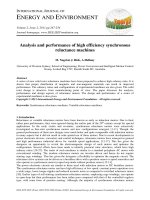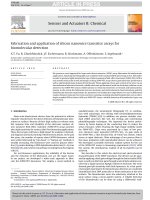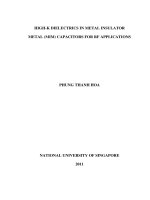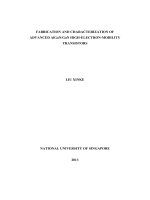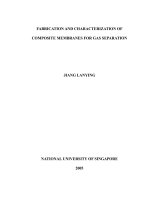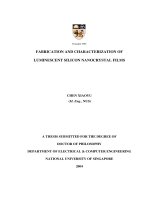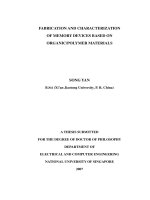Fabrication and characteristics of high k MIM capacitors for high precision applications
Bạn đang xem bản rút gọn của tài liệu. Xem và tải ngay bản đầy đủ của tài liệu tại đây (1.71 MB, 129 trang )
FABRICATION AND CHARACTERISTICS OF HIGH-κ
MIM CAPACITORS FOR HIGH PRECISION
APPLICAITONS
YANG JIAN-JUN
(M. Eng., Chinese Academy of Sciences)
A THESIS SUBMITTED
FOR THE DEGREE OF DOCTOR OF PHILOSOPHY
DEPARTMENT OF ELECTRICAL AND COMPUTER
ENGINEERING
NATIONAL UNIVERSITY OF SINGAPORE
2009
Acknowledgments
I
ACKNOWLEDGMENTS
First of all, I would like to gratefully thank my principle supervisor, Prof. Zhu
Chunxiang, who provided me with invaluable guidance, encouragement, knowledge
and the awesome research opportunities during my graduation study. The relationship
between the student and the advisor is the most important relationship in my graduate
education, which makes me the great research experience. He has my tremendous
appreciation and respect.
I am extremely grateful to my co-supervisor, Prof. Li Ming-fu, not only for his
patience and painstaking efforts in helping me in my research but also for his kindness
and understanding personally, which has accompanied me over the past four years. I
also greatly appreciate my co-supervisor, Prof. Kwong, for all the opportunities
provided in developing my potential and personality.
I would like to take this chance to express my sincere appreciation to Dr. Yeo
Yee-Chia and Dr. Yu Ming bin, for their kindly help and invaluable advices during
my graduation study, lots of collaboration work and fruitful discussions contribute to
my thesis development. My special thanks go to my colleague, Chen Jing-De, for the
technical collaboration and many useful discussions.
I have had the pleasure of collaborating with numerous exceptionally talented
graduate students and colleagues in Silicon Nano Device Lab (SNDL) at NUS over
the last few years. I would like to thank my colleagues in Prof. Zhu’s group, such as
Zhang Chunfu, Fu Jia, Xie Rui Long, Phung Thanh Hoa, for their discussions and
Acknowledgments
II
supports. Many thanks to Yang Weifeng, Zang Hui, Jiang Yu, Pu Jing, Zhang Lu,
Zhao Hui, Shen Chen, Andy Lim Eu-Jin, Zhu Zhen Gang, Wang Xinpeng, Low Wei
Yip. I have benefited the collaboration work with them, and their friendship makes
my stay in NUS more enjoyable. I also would like to extend my appreciation to all
other SNDL teaching staff, fellow graduate students, and technical staff.
Last, and certainly the most, I would like to express my deep gratitude to my
parents Yang Shao-Fang and Dong Gui-Fang, and my wife Gao Lan. I can never
forget their inspiration and encouragement during my education years in spite of the
enormous physical distance between us, their constant love and support made the long
hours and frustrations bearable.
Abstract
III
ABSTRACT
The Metal-Insulator-Metal (MIM) capacitor has been proposed as the next
generation capacitors for precision Radio Frequency (RF) and Analog/Mixed-Signal
(AMS) ICs applications, due to its advantages of depletion–free, high–conductance
electrodes and minimized capacitance loss to Si substrate. Conventional dielectric
materials for MIM capacitors, such as SiO
2
, Si
3
N
4
, cannot satisfy the requirements of
both high-quality and high-density MIM capacitors in the near future according to
ITRS roadmap. The integration of high-κ materials to realize high capacitance density
and low Voltage Coefficient of Capacitance (VCC) in a cost effective way is
imperative.
In this thesis, a systematic research has been done for high-κ MIM capacitors
using Sm
2
O
3
dielectric as base dielectrics. Firstly, the electrical characteristics of
Sm
2
O
3
MIM capacitors with various Sm
2
O
3
thicknesses are investigated, including
voltage linearity and leakage current density. The physical characteristics of Sm
2
O
3
based high-κ MIM capacitor is studied by using techniques such as Transmission
Electron Microscopy (TEM), X-Ray Diffraction (XRD) and X-ray Photoelectron
Spectroscopy (XPS), in which the dielectric constant, crystalline structure are
examined.
Secondly, the effects of Plasma Treatments (PT) with O
2
and/or N
2
on the
performance of MIM capacitors with Sm
2
O
3
dielectric are investigated. It will be
shown that plasma treatment after Sm
2
O
3
dielectric formation can effectively reduce
Abstract
IV
both the quadratic and linear VCC, hysteresis. Also the leakage current density can be
significantly improved. These results indicate that plasma treatment after dielectric
formation is an effective way to improve the performance of high-κ dielectric MIM
capacitors for precision circuit applications. The excellent electrical characteristics of
Sm
2
O
3
MIM capacitors indicate that it is a promising candidate for the application of
high-κ dielectric MIM capacitors.
Thirdly, the MIM capacitors of Sm
2
O
3
stacked with a thin SiO
2
layer to
modulate the effective VCC are investigated. By using the “cancelling effect” of the
positive quadratic VCC of Sm
2
O
3
and the negative quadratic VCC of SiO
2
, MIM
capacitors with high capacitance density, low quadratic VCC and leakage current
density are successfully demonstrated. Such “cancelling effect” of SiO
2
and Sm
2
O
3
dielectrics can be further optimized to obtain higher capacitance density and near zero
quadratic VCC.
Finally, a systematic study of the influence of metal electrodes on the
performance of Sm
2
O
3
MIM capacitors is performed. The improvement of electrical
characteristics is demonstrated by using high work-function metal electrodes while
low work-function metal electrodes show negative effects. The possible reasons of
the interfacial layer formation are discussed.
Table of Contents
V
TABLE OF CONTENTS
ACKNOWLEDGEMENTS I
ABSTRACT III
TABLE OF CONTENTS V
LIST OF FIGURES IX
LIST OF TABLES XIII
Page No.
CHPATER 1
INTRODUCTION
1.1. Radio Frequency and Analog/Mixed-Signal Technologyy… ……… … 1
1.1.1. Background……………………….……………………………….… 1
1.1.2. On chip and Embedded Passives for RF and Analog Technology… 2
1.2. Metal-Insulator-Metal Capacitors for Applications of RF and Analog ICs… 3
1.3. Thesis outline and Contributions………….… …….……………………… 5
References…………………………………………………………… …………… 7
CHAPTER 2
LITERATURE AND TECHNOLIGY REVIEW
2.1. Metal-Insulator-Metal Capacitors………………………….………………….8
Table of Contents
VI
2.2. Parameters of MIM Capacitors for the Applications of RF/AMS ICs… 9
2.3. Literature Review…………………………………………………….………13
2.3.1. Binary Metal Oxides
……………………… ………………….….………………… ………
16
2.3.2. Ternary Metal Oxides and Above………………………….… ….20
2.3.3. Stacked or Multi-layered Metal Oxides………… … ……… ……23
2.4. Summary…………………………………………………………….……….26
References…………………………………………………………… …………….28
CHAPTER 3
SAMARIUM OXIDE (Sm
2
O
3
) HIGH-k DIELECTRIC FOR HIGH
PERFORMANCE MIM CAPACITORS
3.1. Introduction…………………………….…………… …………………… 35
3.2. Experiments………………………………… ………….………… …… 37
3.3. Properties of Sm
2
O
3
High-κ Dielectric for the Applications of MIM
Capacitors……………………………………………………………… … 38
3.3.1. Electrical Characteristics of Sm
2
O
3
MIM Capacitors ………….……38
3.3.2. Physical Characterization of Sm
2
O
3
MIM Capacitors…………… …43
3.4. Performance Improvement of Sm
2
O
3
MIM Capacitors by Using Plasma
Treatment after Dielectric Formation……………….………… ……………45
3.4.1. Voltage Linearity………………………………………… …………46
3.4.2. Leakage Current Density……………………… …………………….50
Table of Contents
VII
3.4.3. Frequency Dependence…………………………………………… 52
3.4.4 Hysteresis and TCC………………… ………………….… ……… 54
3.5. Summary…………………………………….……………………………….57
References…………………………………………… …………………………….59
CHAPTER 4
Sm
2
O
3
/SiO
2
LAMINATED DIELECTRICS FOR MIM CAPACITORS IN
PRECISION ANALOG CIRCUIT APPLICATIONS
4.1. Introduction……………………………………………………………… 64
4.2. Sm
2
O
3
/PVD SiO
2
Laminated Dielectrics MIM Capacitors………… …… 66
4.2.1. Experiments………………………….……………………… … ….66
4.2.2. Electrical Characteristics…………….……………………… … ….68
4.3. Sm
2
O
3
/PECVD SiO
2
Laminated Dielectrics MIM Capacitors………………74
4.3.1. Experiments….………………………………………………… ……74
4.3.2. Electrical Characteristics of PECVD SiO
2
MIM Capacitors…….… 75
4.3.3. Electrical Characteristics of Sm
2
O
3
/PECVD SiO
2
MIM
Capacitors…………………………………………………………….78
4.4. Summary………………………………………… ……….……………… 87
Reference…………………………………………………………….……………….88
Table of Contents
VIII
CHPATER 5
INFLUENCE OF METAL ELECTRODES ON THE PERFORMANCE OF
Sm
2
O
3
MIM CAPACITORS
5.1. Introduction……………………………………………………… ……… 89
5.2. Experiments……………………………………………….………… …… 90
5.3. Properties of Sm
2
O
3
MIM Capacitors with Different Metal Electrodes…… 91
5.3.1. Sm
2
O
3
MIM Capacitors with High Work-Function Metal
Electrodes………………………………………………… …… …91
5.3.2. Sm
2
O
3
MIM Capacitors with Low Work-Function Metal
Electrodes………………………………………………………….…99
5.3. Summary………………………………………………………………… 106
Reference……………………………………………………………………………107
CHAPTER 6
CONCLUSION AND FUTURE WORKS
6.1. Conclusion…………………………………………………………… ……110
6.2. Future works…………………………………… ……………….… …….112
APPENDIX – LIST OF PUBLICATIONS 114
List of Figures
IX
Fig. 2.1. Typical schematic of MIM capacitor used in the AlCu BEOL.
9
Fig. 2.2. Polynomial fitting of a typical C-V curve. The fitting is performed
from positive voltage to negative or reverse.
10
Fig. 2.3. Dielectric permittivity κ versus band gap for oxides [2.22]. It is observed
that dielectric with higher permittivity usually has lower band-gap.
15
Fig. 3.1. (a) Normalized capacitance (ΔC/C
0
) measured at 100 kHz for MIM
capacitors with a single Sm
2
O
3
dielectric layer with the capacitance
density varied. By fitting a second-order polynomial equation to the
experimental curves, the quadratic VCC (α) and the linear VCC (β) are
obtained. (b) Summary of both quadratic VCC and linear VCC versus
capacitance density.
39
Fig. 3.2. The values of quadratic VCC extracted from MIM capacitors with a
single Sm
2
O
3
dielectric layer in this work are compared with data
published in the literature.
40
Fig. 3.3. J-V characteristics at room temperature of MIM capacitors with a single
Sm
2
O
3
dielectric layer at the capacitance of 9.5, 7.9, and 5.7 fF/μm
2
,
respectively. The J-V curve becomes asymmetric at higher DC bias,
indicating that the MIM capacitor may have physically asymmetric, i.e.
different electrode-dielectric interface quality for the bottom and top
interfaces.
42
Fig. 3.4. Plot of ln(J/E) versus E
1/2
of the capacitor with different capacitance
density, together with the linear fitting for the leakage current at positive
bias.
42
Fig. 3.5. TCC characteristic of Sm
2
O
3
MIM capacitors measured from 27 to 120
o
C. The capacitance variation increases linearly with the increasing of
the temperature.
43
Fig. 3.6. The TEM image of the MIM capacitor with a single Sm
2
O
3
layer. It
should be noted that the Sm
2
O
3
layer is poly-crystalline.
44
Fig. 3.7. X-Ray Diffraction (XRD) spectra of as-deposited Sm
2
O
3
dielectric on
TaN, as well as Sm
2
O
3
/TaN after being annealed at 400 ºC for 60 s.
XRD spectrum of an exposed TaN surface is also obtained.
As-deposited Sm
2
O
3
on TaN is shown to be likely poly-crystalline.
45
Fig. 3.8. Quadratic VCC versus capacitance density of Sm
2
O
3
MIM capacitors 47
List of Figures
X
without or with plasma treatment (PT). The inset shows the influence
of PT duration on the quadratic VCC.
Fig. 3.9. (a) Normalized C-V curves of Sm
2
O
3
MIM capacitors with Plasma
Treatment in N
2
(PTN) after bottom electrode formation, PTN after
dielectric formation, PTN in both steps, and with no PTN. (b)
Summary of the quadratic and linear VCC of Sm
2
O
3
MIM capacitors
after various PTN conditions. The best VCC values are obtained by
using PTN after dielectric formation.
48
Fig. 3.10. (a) The J-V curves of Sm
2
O
3
MIM capacitors after different PTN. (b)
Summary of the leakage current density J obtained at +3.3 V for MIM
capacitors with Sm
2
O
3
dielectric.
51
Fig. 3.11. Frequency dispersion of the capacitance density (a) and the quadratic
VCC (b) of Sm
2
O
3
MIM capacitors with or without PTN. The
capacitance density shows small dependence on the frequency while the
quadratic VCC has a linear relationship with the frequency.
53
Fig. 3.12. Hysteresis of the capacitance density of Sm
2
O
3
MIM capacitors after
various PTN conditions.
54
Fig. 3.13. Temperature dependence of Sm
2
O
3
MIM capacitors after various PTN
conditions.
55
Fig. 3.14. Bonding energy of O 1s (a) and Sm 3d5 (b) of Sm
2
O
3
dielectric with or
without PTN after Sm
2
O
3
dielectric formation.
56
Fig. 4.1. Quadratic VCC (α value) versus capacitance density of HfO
2
and Sm
2
O
3
(with or without PTN). Sm
2
O
3
MIM with PTN on Sm
2
O
3
dielectrics
can obtain much lower quadratic VCC.
66
Fig. 4.2. Schematic of PVD SiO
2
/Sm
2
O
3
MIM capacitors. Note that Sm
2
O
3
layer was deposited prior to SiO
2
layer.
67
Fig. 4.3. Typical C-V curves of PVD SiO
2
MIM capacitors with (a) 10 nm and (b)
5 nm sputtered SiO
2
. PTN shows improvement on both quadratic VCC
and linear VCC.
69
Fig. 4.4. Normalized C-V curves of Sm
2
O
3
/PVD SiO
2
MIM capacitors with SiO
2
thicknesses at (a) 2 nm and (b) 3 nm. (c) Summary of capacitance
density versus quadratic VCC. By increasing the thickness of SiO
2
from 2 nm to 3 nm, the effective quadratic VCC is modulated from 545
to 432 ppm/V
2
at the capacitance density at 8 fF/μm
2
.
71
&
72
List of Figures
XI
Fig. 4.5.
Summary of the electrical characteristics of (a) leakage current densities
at +5 V and (b) breakdown voltage versus capacitance density.
73
Fig. 4.6. (a) C-V curve of MIM capacitors with a single PECVD SiO
2
layer. (b)
Summary of both quadratic and linear VCC versus the capacitance
density.
76
Fig. 4.7. Simulated α versus SiO
2
thickness plot for different Sm
2
O
3
thicknesses
from 3 to 10 nm. The value of α should preferably be within the range
of ±100 ppm/V
2
, as indicated by the horizontal dashed lines. The
quadratic VCC is sensitive to the thicknesses of both SiO
2
and Sm
2
O
3
.
77
Fig. 4.8. TEM image of Sm
2
O
3
/PECVD SiO
2
MIM capacitor. 79
Fig. 4.9. EOT versus SiO
2
thickness of Sm
2
O
3
/SiO
2
MIM capacitors with the
Sm
2
O
3
thickness at 6, 7.5, 8.5 and 10 nm, respectively.
80
Fig. 4.10. Normalized C-V curves of Sm
2
O
3
/SiO
2
MIM capacitors with SiO
2
thickness varying from 3, 3.5, 4, 5, to 7 nm, and Sm
2
O
3
thicknesses
being fixed at 7.5 nm. Sm
2
O
3
and SiO
2
MIM with comparable
capacitance densities are also included. The effective quadratic VCC
(α value) is modulated from positive to negative values by increasing
SiO
2
thickness.
81
Fig. 4.11. (a) Quadratic VCC versus capacitance density and (b) quadratic VCC
versus SiO
2
thickness (3 to 7 nm) for Sm
2
O
3
thicknesses being varied
(6.5, 7.5, 8.5, and 10 nm). Inset of (b) shows linear VCC versus SiO
2
thickness with varying the thickness of SiO
2
and Sm
2
O
3
. The linear VCC
can be modulated to near zero by increasing the thickness of SiO
2
.
82
Fig. 4.12. Frequency dispersion of the capacitance density and loss tangent of
Sm
2
O
3
/SiO
2
MIM capacitors, with Sm
2
O
3
being fixed at 7.5 nm while
varying SiO
2
thickness from 3 to 7 nm.
84
Fig. 4.13. Summary of the leakage current densities of Sm
2
O
3
/SiO
2
MIM
capacitors with various combinations of Sm
2
O
3
(6.5, 7.5, 8.5, and 10
nm) and SiO
2
thicknesses. Inset shows the typical J-V curves.
85
Fig. 4.14. Cumulative probability of breakdown field of Sm
2
O
3
MIM capacitors.
85
Fig. 4.15. J-V curves of Sm
2
O
3
/SiO
2
capacitors with an 8.5 nm thick Sm
2
O
3
and a
3.5 nm thick SiO
2
measured from 27 to 120 °C.
86
Fig. 5.1. Normalized C-V curves of Sm
2
O
3
MIM capacitors with TaN, Ni and Pt 92
List of Figures
XII
electrodes, respectively.
Fig. 5.2. Summary of quadratic VCC (a) and linear VCC (b) of Sm
2
O
3
with Ni, Pt
and TaN bottom electrode. Both the quadratic and linear VCC can be
reduced by using Pt electrodes.
93
Fig. 5.3. (a) J-V curves of Sm
2
O
3
MIM capacitors with TaN, Ni, and Pt
electrodes. Significantly leakage reduction of the capacitor by using Pt
electrode can be obtained. (b) Summary of leakage at +3.3 V versus
capacitance density.
94
&
95
Fig. 5.4. (a) SIMS depth profile of the Sm
2
O
3
capacitor with
TaN/Ni/Sm
2
O
3
/Ni/TaN structure. (b) EDX results of Ni/Sm
2
O
3
/Ni
structures. The material study shows the inter-diffusion of Ni and Sm
elements.
96
Fig. 5.5. Comparison of the hysteresis of the capacitance density of Sm
2
O
3
MIM
capacitors with TaN, Ni and Pt electrodes, respectively.
97
Fig. 5.6. Comparison of the temperature dependence of the capacitance of Sm
2
O
3
MIM capacitors with TaN, Ni and Pt electrodes, respectively.
98
Fig. 5.7. Normalized C-V curves of Sm
2
O
3
MIM capacitors with Al, HfN, and
TaN, electrodes, respectively.
99
Fig. 5.8. Summary of quadratic VCC (a) and linear VCC (b) of Sm
2
O
3
with Al,
HfN and TaN bottom electrodes, respectively.
100
Fig. 5.9. SIMS depth profile of the Sm
2
O
3
capacitor with HfN electrodes.
102
Fig. 5.10. (a) TEM image and (b) EDX analysis of HfN/Sm
2
O
3
/HfN MIM
capacitor.
102
Fig. 5.11. (a) J-V curves of Sm
2
O
3
MIM capacitors with Al, HfN, and TaN
electrodes. (b) Summary of leakage @ +3.3 V versus capacitance
density. The capacitor with an HfN electrode shows a smaller leakage
current density.
103
Fig. 5.12. Comparison of the hysteresis of the capacitance density of Sm
2
O
3
MIM
capacitors with Al, HfN and TaN electrodes.
104
Fig. 5.13. Comparison of the temperature dependence of the capacitance of Sm
2
O
3
MIM capacitors with Al and TaN electrodes, respectively.
105
List of Tables
XIII
Table 1.1. On-Chip Passive Technology Requirements ― Short-term.
4
Table 1.2. On-Chip Passive Technology Requirements ― Long-term.
5
Table 2.1. Comparison of dielectric permittivity, gap energy and for different
high-κ dielectric candidates, including SiO
2
and Si
3
N
4
.
15
Table 2.2. List of electrical characteristics of binary high-κ dielectric MIM
capacitors reported recently.
18
Table 2.3. List of electrical characteristics of ternary and above high-κ MIM
capacitors reported recently.
22
Table 2.4. List of electrical characteristics of stacked high-κ MIM capacitors
reported.
25
Table 4.1. Split table for MIM capacitors with Sm
2
O
3
/SiO
2
laminate dielectric. 78
Chapter 1: Introduction
1
CHAPTER 1
INTRODUCTION
1.1. Radio Frequency and Analog/Mixed-Signal Technology
1.1.1. Background
Radio Frequency (RF) and Analog/Mixed-Signal (AMS) technologies show
essential and critical technologies for many semiconductor and Integrated Circuits
(ICs) products. Such technologies now serve the rapidly growing market of both
internet and wireless communications, such as hand phones and other wireless devices.
RF/AMS circuits process radio signals (analog signals) and digital data, some of
which includes RF, analog, digital to analog and analog to digital conversions.
These technologies depend on many materials and processing technologies, some of
which are compatible with Complementary Metal Oxide Semiconductor (CMOS)
processing and others are not, e.g., those compound semiconductors.
The drivers for most of RF/AMS products are cost, frequency bands, power
consumption, functionality, size, production volume, standards and protocols.
Considering these requirements and also being required to perform according to
preset standard specifications, scaling transistor dimensions alone is insufficient for
Chapter 1: Introduction
2
these products. Therefore, a technology of “System-on-a-Chip (SoC)” to integrate
the Digital Signal Processors (DSP) with other analog functions was developed.
This technology can maintain a competitive edge for these RF/AMS products with
comparable cost and performance.
1.1.2. On chip and Embedded Passives for RF and Analog Technology
Passive components include resistors, capacitors, inductors, varactors,
transformers, and transmission lines. These components are frequently used for
impedance matching, resonance circuits, filters, and bias circuits in Radio Frequency
Integrated Circuits (RFICs). Unlike active devices such as Metal Oxide
Semiconductor Field Emission Transistor (MOSFET) in the Ultra Large Scale
Integrated circuit (ULSI) technology for digital CMOS ICs, the performance of many
RF/AMS circuits are mainly determined by the performance of these passive elements.
This is because that even in some RF circuits, the performance of RF/AMS CMOS
transistors is usually good enough for most of the applications well beyond 10 GHz
[1.1].
Integrating passives components into RF/AMS ICs has been now progressing in
the era of SoC in order to realize RF/AMS CMOS technology with high performance
and low cost, particularly for some consumer electronic devices. When
incorporating such passives component into a standard CMOS process, some
additional processing steps such as photolithography are needed. Moreover, new
Chapter 1: Introduction
3
materials such as using high-permittivity (κ) dielectrics may be also required to obtain
better passive performance. This is because that these passive components, such as
capacitors and inductors, usually occupy much more chip area than active devices.
To obtain smaller die size, another optimization scheme or research should be
performed to increase the capacitance density. This might be realized by extra
process steps or adding process complexity such as introducing new materials or new
device structures. The requirements for embedded passive components are the same
to those of surface mount passive components. Embedded passives technologies
involve additional material such as using high-κ dielectric for capacitors, resistive
layer for resistors, and high permeability material for inductors.
1.2. Metal-Insulator-Metal Capacitors for Applications of RF and Analog ICs
Among these basic passive devices, capacitor is one of the essential elements,
which are usually employed for decoupling, filtering and oscillating in the
applications of RF/AMS ICs [1.2]. Conventional capacitors are
Polysilicon-Insulator-Polysilicon (PIP) and MOS devices [1.3, 1.4]. However,
polysilicon electrode has the unavoidable depletion effects and large sheet resistance,
which cannot be accepted for the high precision requirements for scaled processing
technologies [1.5, 1.6]. Therefore, a capacitor with metal electrodes, which is
known as Metal-Insulator-Metal (MIM) capacitor, has been developed.
The key parameters of MIM capacitors for RF applications are capacitance
Chapter 1: Introduction
4
density, voltage linearity, leakage, matching and quality (Q) factor [1.1]. Higher
capacitance density is required because of capacitor area scaling. The matching
tolerances become smaller also due to the capacitance area scaling down. According
to the International Technology Roadmap for Semiconductors 2007 (ITRS roadmap),
the main requirements and specifications of short term and long term for MIM
capacitors are summarized in Table 1.1 and Table 1.2, respectively, where aggressive
projections have been extent to year 2022 with ever increased performance
requirements. The detailed requirements will be presented in Chapter 2.
Table 1.1. On-Chip Passive Technology Requirements ― Short-term.
Year of Production 2009 2010 2011 2012 2013 2014 2015
Metal-Insulator-metal Capacitor
Density (fF/µm
2
) 4 5 5 5 7 7 7
Voltage linearity (ppm/V
2
) <100 <100 <100 <100 <100 <100 <100
Leakage (A/cm
2
) <1e-8 <1e-8 <1e-8 <1e-8 <1e-8 <1e-8 <1e-8
σ Matching (%•µm) 0.5 0.5 0.4 0.4 0.3 0.3 0.3
Q (5GHz for 1pF) >50 >50 >50 >50 >50 >50 >50
MOM Capacitor
Density (fF/µm
2
) 5.3 6.2 7.0 6.5 7.5 8.6 9.9
Voltage linearity (ppm/V
2
) <100 <100 <100 <100 <100 <100 <100
s Matching (% for 1pF) <0.15 <0.15 <0.15 <0.15 <0.1 <0.1 <0.1
Chapter 1: Introduction
5
Table 1.2. On-Chip Passive Technology Requirements ― Long-term.
Year of Production 2018 2020 2022
Metal-Insulator-metal Capacitor
Density (fF/µm
2
) 10 12 12
Voltage linearity (ppm/V
2
) <100 <100 <100
Leakage (A/cm
2
) <1e-8 <1e-8 <1e-8
σ Matching (%•µm) 0.2 0.2 0.2
Q (5GHz for 1pF) >50 >50 >50
MOM Capacitor
Density (fF/µm
2
) 15.1 20.0 26.4
Voltage linearity (ppm/V
2
) <100 <100 <100
s Matching (% for 1pF) <0.1 <0.08 <0.08
Manufacturable Solutions Exist, and are being optimized
Manufacturable Solutions are known
Manufacturable Solutions are no known
1.3. Thesis Outline and Contributions
In Chapter 2, the key parameters of MIM capacitors for high precision circuit
applications are detailedly introduced and a systematic review of recent studies on
Chapter 1: Introduction
6
high-κ dielectric MIM capacitors is presented.
In Chapter 3, the electrical and physical characteristics of MIM capacitors with a
single Sm
2
O
3
dielectric have been systematically investigated. Moreover, the
influence of plasma treatment on the performance of Sm
2
O
3
MIM capacitors has been
described. Plasma treatment in N
2
ambient after dielectric formation can be utilized
to improve the performance of high-κ dielectric MIM capacitors.
In Chapter 4, the MIM capacitors of Sm
2
O
3
stacked with a Physical Vapor
Deposition (PVD) or a Plasma Enhanced Chemical Vapor Deposition (PECVD) SiO
2
layer have been fabricated and characterized. The application of using a thin SiO
2
layer to modulation the voltage linearity of whole dielectric stack is presented.
In Chapter 5, the influence of metal electrodes on the performance of Sm
2
O
3
MIM capacitors has been systematically investigated. The improvement of electrical
characteristics by using high work-function metal electrodes is presented.
Finally, Chapter 6 concludes with suggestions for future work based on the
conclusion of this thesis.
Chapter 1: Introduction
7
Reference:
[1.1]. “RF and analog/mixed-signal technologies for wireless communications,” in
International Technology Roadmap for Semiconductors 2007. San Jose, CA.
[1.2]. Chit Hwei Ng, Chaw-Sing Ho, Shao-Fu Sanford Chu, and Shi-Chung Sun, “MIM
Capacitor Integration for Mixed-Signal/RF Applications,” IEEE, Trans on Electron
Devices, Vol. 52, No. 7, July 2005;
[1.3]. T. Iida, M. Nakahara, S. Gotoh, and H. Akiba, “Precise capacitor structure suitable
for submicron mixed analog/digital ASICs,” in Proc. IEEE Custom Integration
Circuits Conf., 1990, pp. 18.5.1–18.5.4.
[1.4]. A. S. St Onge, S. G. Franz, A. F. Puttlitz, A. Kalinoski, B. E. Johnson,and B.
El-Kareh, “Design of precision capacitors for analog applications,” IEEE Trans.
Compon., Hybrids, Manufact. Technol., vol. 15, no.4, pp. 1064–1071, Dec. 1992.
[1.5]. C. Kaya, H. Tigelaar, J. Paterson, M. D. W. J. Fattaruso, D. Hester, S.Kiriakai, K. S.
Tan, and F. Tsay, “Polycide/metal capacitors for high precision A/D converters,” in
IEDM Tech. Dig., 1988, pp. 782–785.
[1.6]. T. Ishii, M. Miyamoto, R. Nagai, T. Nishida, and K. Seki, “0.3 μm mixed
analog/digital CMOS technology for low-voltage operation,” IEEE Trans. Electron
Devices, vol. 41, no. 10, pp. 1837–1842, Oct. 1994.
Chapter 2: Literature and Technology Review
8
CHAPTER 2
LITERATURE AND TECHNOLIGY REVIEW
2.1. Metal-Insulator-Metal Capacitors
For the capacitors used in the applications of RF/AMS ICs, precision capacitance
control within different bias voltage and temperature is required. Traditional
Polysilicon-Insulator-Polysilicon (PIP) capacitors cannot be tolerated in RF/AMS ICs
due to the undesirable depletion effects of polysilicon electrodes [2.1-2.4]. Although
cross-coupled capacitors have been employed to alleviate the capacitance variation
[2.1], the resistivity of capacitors is large, and quality factor (Q) is poor due to the
excessive capacitance-loss to the substrate. Therefore, the requirement of capacitor
electrodes with little or no depletion effects motives the employment of metal
electrodes. It is generally known as Metal-Insulator-Metal (MIM) structures.
The MIM capacitor has been proposed as the next generation capacitor for
RF/AMS ICs applications, due to its advantages of depletion–free, high–conductance
electrodes and minimized capacitance loss to Si substrate [2.5-2.9]. Fig. 2.1 shows
the typical schematic of MIM capacitor in the AlCu Back-End of Line (BEoL).
There is a thin metal electrode inserted between the two metal layers. The
conventional dielectrics used in industries are usually SiO
2
or Si
3
N
4
which are
Chapter 2: Literature and Technology Review
9
deposited by PECVD at the low-temperature process below 500
o
C. The capacitors
are usually done between the last top two metal layers so as to reduce the substrate
coupling effect.
Top metal layer
Standard BEOL metal layer of
Ti/TiN/AlCu.
PECVD SiO
2
or Si
3
N
4
MIM top plate
Fig. 2.1. Typical schematic of MIM capacitor used in the AlCu BEoL.
2.2. Parameters of MIM Capacitors for the Applications of RF/AMS ICs
The key parameters for MIM capacitors in the application of RF/AMS ICs are
capacitance density, voltage linearity, leakage current density, matching and Q factor
[2.10]. The details of specified requirements are list below:
Chapter 2: Literature and Technology Review
10
(1) Capacitance density
Capacitance density is one of the essential issues of MIM capacitors because
capacitors usually occupy much area in a chip. The areal percentage of capacitor
significantly increases within the scaling down of ICs. To increase the capacitance
per unit area can improve the capacitor integration and thus reduce the cost.
(2) Voltage linearity
The variation of capacitance with the applied voltage is known as the Voltage
Coefficient of Capacitance (VCC), as shown in Fig. 2.2. The precision capacitance
control needs small capacitance variation with the applied voltage varied.
-4 -2 0 2 4
0.000
0.003
0.006
0.009
0.012
0.015
0.018
C(V) = C
0
(αV
2
+βV+1)
Bias (V)
ΔC/C
0
Polynomial fit
Figure 2.2. Polynomial fitting of a typical C-V curve. The fitting is performed from
positive voltage to negative or reverse.
Chapter 2: Literature and Technology Review
11
Usually VCC can be approximated by equation 2.1.
C(V) = C
0
(αV
2
+βV+1) [2.9], (2.1)
where V is the voltage applied between the electrodes of the capacitor, and C
0
is
the capacitance at zero voltage. α, β are the quadratic and linear VCC, respectively.
The quadratic VCC (α value) is critical for the dynamic range of analog circuit [2.10].
The linear VCC (β value) can be cancelled out by differential techniques such as
cross-coupled arrangement [2.1].
(3) Temperature coefficient of capacitance (TCC)
The temperature coefficient of capacitance (TCC) is an important parameter of
MIM capacitors as the actual device temperature during the circuit operation is
usually much higher than room temperature and is usually expressed in ppm/ºC.
TCC describes the maximum change in capacitance over a specified temperature
range. TCC can be usually defined as:
Cppm
dT
dC
T
TCC
o
/
10
6
= [2.11, 2.12] (2.2)
TCC is usually positive because of the effect of larger inter-atomic space at
higher temperature, which allows a larger dipole moment in the presence of an
electric field [2.13, 2.14]. A TCC parameter which is under about 200 ppm/ºC is
considered low.
